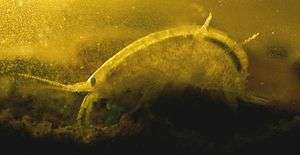Gammarus lacustris
| Gammarus lacustris | |
|---|---|
 | |
| Scientific classification | |
| Kingdom: | Animalia |
| Phylum: | Arthropoda |
| Subphylum: | Crustacea |
| Class: | Malacostraca |
| Order: | Amphipoda |
| Family: | Gammaridae |
| Genus: | Gammarus |
| Species: | G. lacustris |
| Binomial name | |
| Gammarus lacustris G. O. Sars, 1863 | |
Gammarus lacustris is an aquatic amphipod.
Description
G. lacustris is semi-transparent and lacks a webbed tail. It may be colorless, brown, reddish or bluish in color, depending on the local environment. It has seven abdominal segments, a fused cephalothorax, and two pairs of antennae. Unlike other crustaceans, amphipods lack carapaces and have laterally compressed bodies. Gammarids are referred to as scuds or sideswimmers. G. lacustris resembles a freshwater shrimp.
Life cycle
The female carries eggs in a brood pouch on its ventral side. G. lacustris in higher elevations were more likely to have fewer but larger eggs than those living at lower elevations.[1] G. lacustris undergoes several molts and juveniles resemble the adult.
Ecology
G. lacustris plays an important role in many of the freshwater ecosystems that it inhabits. It is a detritivore and may also consume algae, mainly diatoms.[1] It is considered an indicator species for the overall health and stability of the ecosystem.
As a small aquatic invertebrate G. lacustris is an important food source for many organisms. Birds, fishes, and some insects have been known to prey upon G. lacustris. It is often susceptible to parasitism, acting as an intermediate host for several parasites.[2] It typically exhibits photophobic behavior, but when parasitized it may show photophilic behavior.[3] A parasite often modifies its host's behavior.[2][4] Parasites can affect the diel migration of G. lacustris, making it more visible and susceptible to predation.[2][4][5][6] More mature parasites have greater effects on hosts.[7]
Distribution
G. lacustris has been noted in northwestern Europe, Russia, and North America.[1][8] Its precise range has yet to be defined. It can be found in shallow or deep lakes and in slow-moving rivers. It is more abundant in fishless lakes than in those with fish. Its distribution follows the thermocline in the water.[8]
References
- 1 2 3 F. M. Wilhelm; D. W. Schindler (2001). "Reproductive strategies of Gammarus lacustris (Crustacea: Amphipoda) along an elevation gradient". Functional Ecology. 14 (4): 413–422. doi:10.1046/j.1365-2435.2000.00426.x. JSTOR 2656534.
- 1 2 3 Janice Moore (1984). "Altered behavioral responses in intermediate hosts – an acanthoceptalan parasite strategy". The American Naturalist. 123 (4): 572–577. doi:10.1086/284224. JSTOR 2461000.
- ↑ Marie-Jeanne Perrot-Minnot (2003). "Larval morphology, genetic divergence, and contrasting levels of host manipulation between forms of Pomphorhynchus laevis". International Journal for Parasitology. 34 (1): 45–54. doi:10.1016/j.ijpara.2003.10.005. PMID 14711589.
- 1 2 K. D. Lafferty (1999). "The evolution of trophic transmission". Parasitology Today. 15 (3): 111–115. CiteSeerX 10.1.1.58.1452
 . doi:10.1016/S0169-4758(99)01397-6. PMID 10322324.
. doi:10.1016/S0169-4758(99)01397-6. PMID 10322324. - ↑ Robert Poulin (1995). ""Adaptive" changes in the behaviour of parasitized animals: a critical review". International Journal for Parasitology. 25 (12): 1371–1383. doi:10.1016/0020-7519(95)00100-X. PMID 8719948.
- ↑ F. Thomas; R. Poulin (1998). "Nonmanipulative parasites in manipulated hosts: 'hitchhikers' or simply 'lucky passengers'?". The Journal of Parasitology. 84 (5): 1059–1061. JSTOR 3284648. PMID 9794658.
- ↑ N. Franceshi; A. Bauer; L. Bollache; T. Rigaud (2008). "The effects of parasite age and intensity on variability in acanthocephalan-induced behavioural manipulation". International Journal for Parasitology. 38 (10): 1161–1170. doi:10.1016/j.ijpara.2008.01.003. PMID 18314127.
- 1 2 Egor S. Zadereev; Alexander P. Tolomeyev; Anton V. Drobotov; Anna Yu. Emeliyanova; Mikhail V. Gubanov (2010). "The vertical distribution and abundance of Gammarus lacustris in the pelagic zone of the meromictic lakes Shira and Shunet (Khakassia, Russia)". Aquatic Ecology. 44 (3): 531–539. doi:10.1007/s10452-010-9329-5.
Further reading
- Cezilly, Frank; Marie-Jeanne Perrot-Minnot (2005). "Studying adaptive changes in the behaviour of infected hosts: a long and winding road". Behavioural Processes. 68 (3): 223–228. doi:10.1016/j.beproc.2004.08.013. PMID 15792694.
- Medoc, Vincent, Thierry Rigaurd, Loic Bollache & Jean-Nicolas Beisel (2009). "A manipulative parasite increasing an antipredator response decreases its vulnerability to a nonhost predator". Animal Behaviour. 77 (5): 1235–1241. doi:10.1016/j.anbehav.2009.01.029.
- Price, P. W., Carl E. Bouton, Paul Gross, Bruce A. McPheron, John N. Thompson & Arthur E. Weis (1980). "Interactions among three trophic levels: influence of plants on interactions between insect herbivores and natural enemies" (PDF). Annual Review of Ecology and Systematics. 11: 41–65. doi:10.1146/annurev.es.11.110180.000353.